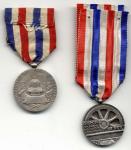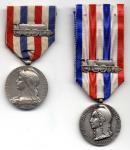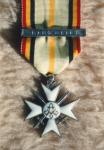-
Posts
1,116 -
Joined
-
Last visited
-
Days Won
1
Everything posted by Hendrik
-

Netherlands Belgian WW1 Diploma...
Hendrik replied to Chris Boonzaier's topic in Northern European & Baltic States
Hello Jan, Excellent ! Thanks for the information ! Do let us know more on this if/when you find further details Cheers, Hendrik -

Belgium Painting of Belgian Captain
Hendrik replied to Jef's topic in Northern European & Baltic States
Jef, I believe he was from Doornik (born and died there ... 1902-1971) and do think there's something odd about the picture : first there's the Fire Cross as you pointed out but what about the top row of medals ? Doesn't the good captain appear to be very young to have all those long service awards ? Even counting double the war years, he couldn't still be a captain with all those awards, could he ? Just an idea : original picture from 1923 and painted over with the new medals in the 1930's ??? Maybe your friend can check the original with that in mind ... Cheers, Hendrik -

Netherlands Belgian WW1 Diploma...
Hendrik replied to Chris Boonzaier's topic in Northern European & Baltic States
Jef, Forgot to mention something in my previous post : I noticed the Yser Medal in the group ... how can that be there if he saw service from October 1916 onwards ? Only participants of the October 1914 battles could receive that one ! Hendrik -

Netherlands Belgian WW1 Diploma...
Hendrik replied to Chris Boonzaier's topic in Northern European & Baltic States
Hello Jef, The Commemorative Medal should indeed have a red cross device on its ribbon - not so sure about the star device (working from memory I think that needed a change of branch due to a wound or illness but you mention he returned to his unit). Receiving the fire card (and Fire Cross) doesn't necessarily mean a minimum of one year of frontline service, e.g. 9 months in the final push (28 Sept to 11 Nov. 1918) would suffice. However, being wounded in 1916, regaining his unit afterwards and surviving the war does point towards at least one or more front stripes. I take it you don't have the actual fire card in your possession ? That would remove all doubts as all awards one is entitled to are listed on it. The lion device on the war cross (Croix de Guerre) ribbon is of a later type and might indicate a late award of the decoration itself or replacement for a lost original. This might just explain the absence of the Comm. Medal's devices : perhaps they were lost as well and never replaced by your relative ... but this is just guesswork, I'm afraid. Cheers, Hendrik -
Mmm, I read that date on the box as 21 June 1946 ... am I wrong ? Cheers, Hendrik
-

Belgium belgian Order of Leopold l
Hendrik replied to Laurence Strong's topic in Northern European & Baltic States
... and I intend to be looking over your shoulder when you do Really gorgeous one !!! -

Belgium Price enquiry with regards Belgian Medal
Hendrik replied to Kev in Deva's topic in Northern European & Baltic States
Hello Kevin, I think a fair price for this medal these days would be something like 40 Euros although it often sells for more than that amount. The double striped ribbon is usually considered rarer than the single striped one. Cheers, Hendrik -
Gents, I had the pleasure of interviewing a Belgian recipient of the Silver Carnegie Hero Fund Medal last Monday and thought a couple of pictures here wouldn't do any harm as one doesn't often encounter this award For the man's complete story and entire medal group, I refer to my website at Hendrik's Medal Corner in the "Hall of Honours" section there but here's why he was awarded it : "Obviously the most striking medal within this group is the rare Silver Carnegie Hero Fund Medal which August De Wit earned in 1963 : on Sunday, 29 September of that year, close to midnight, August and his team were in their patrol car when they received a call that a car had plunged into a nearby canal. Upon arrival on the scene, they found the car was totally submerged, three passengers had already managed to save themselves and a fourth passenger was still standing on top of the car, yelling the driver was still inside. August - who had already discarded his uniform in the car - immediately jumped into the cold water of the canal and dived to the sunken car. While inside the car trying to get hold of the unconscious driver, the car door closed behind him and he had to free himself to go up for air. On his second dive, he got hold of the driver's jacket but it slipped off its wearer. After coming up for air again, August finally managed to get the man out with his third dive into the car. Once ashore and despite abrasions to both his legs, an exhausted August immediately applied mouth-to-mouth resuscitation until relieved by his brother who, living nearby, had appeared on the scene in the meantime. In the end an ambulance took the still unconscious driver to hospital from where he was later discharged after his full recovery." Cheers, Hendrik [attachmentid=52365] [attachmentid=52367]
-

Belgium Belgium - Commemorative Medal of the War 1914-1918
Hendrik replied to a topic in Northern European & Baltic States
I have my doubts as well on the helmeted figure being King Albert I : - the official description of the medal's obverse doesn't mention it to be him but merely a "helmeted soldier" whereas in other medals' descriptions the "head of King Albert I" is specified, - if it were the king, in military uniform, I would expect his rank insignia to be visible as well Just my two Eurocents worth, Hendrik -

France French Médaille d'Honneur des Chemins de Fer
Hendrik replied to Michael Johnson's topic in France
-

France French Médaille d'Honneur des Chemins de Fer
Hendrik replied to Michael Johnson's topic in France
Hi Michael, Nice ones indeed ... here's two others : 1st type and its Colonial nephew. Obverse : [attachmentid=51678] -

Belgium Belgium - Commemorative Medal of the War 1914-1918
Hendrik replied to a topic in Northern European & Baltic States
Hello Jef, They are meant for a miniature WWI Commemorative Medal. The bars are painted black (as opposed to the black enameled posthumous award bar) Excellent ! Cheers, Hendrik -

Belgium Belgium - WW2 Armed Resistance Medal 1940-45
Hendrik replied to a topic in Northern European & Baltic States
Jacky, There is an appropriate section on this forum, the "Sale Room", where you can put up the group as for sale ... Just offer it there with the price you want for it. It's bound to get more attention there than hidden away in this topic on just one medal ! Cheers, Hendrik -
Hello Rick, Found this on what could be "your man" : Ferdinando Pio Maria, Duke of Calabria, Prince of the Two Sicilies (Duca di Calabria, Principe delle Due Sicilie) born July 25, 1869, Rome, Papal States (now Italy) died January 7, 1960, Lindau, Bavaria, Germany son of Prince Alfonso of the Two Sicilies, Count of Caserta, and of his wife, Princess Antonia of the Two Sicilies; Grand Master of the Constantinian Order of Saint George and of the (Sicilian) Order of Saint Januarius, Bailiff Grand Cross of Honour and Devotion of the Sovereign Military Order of Malta, Knight of the (Spanish) Order of the Golden Fleece (from 1897), of the (Bavarian) Order of Saint Hubert, and of the (Italian) Order of the Annunciata, Grand Cross of the (Spanish) Order of Charles III Source : http://www.jacobite.ca/genealogy.htm Hope this helps, Hendrik
-

Belgium Belgisch Aalmoezenierskruis 1889-1920
Hendrik replied to oli4vercammen's topic in Northern European & Baltic States
Excellent example of this rare badge ! Thanks for sharing it. Hendrik -

Belgium Belgium - WW2 Armed Resistance Medal 1940-45
Hendrik replied to a topic in Northern European & Baltic States
Jacky, We are both wrong : working from (an obviously failing) memory, I mistakenly mentioned the captivity period for the Political Prisoner's Cross ... Requirement for a bar on the POW medal is 12 months captivity (max. 5 bars can thus be awarded although the last one then is not for a complete year) ! So any POW released before a year had passed, would not have a bar on his medal's ribbon. But we are digressing : this topic is on the Armed Resistance Medal ! Cheers, Hendrik -

Belgium Belgium - Commemorative Medal of the War 1914-1918
Hendrik replied to a topic in Northern European & Baltic States
Indeed a nice picture and yes, Jacky, you are correct in your identification ... Belgian chivalry orders awarded for an act of merit or valour in wartime carry a palm device on their ribbons. However, this device is removed and a black enameled bar is put on the ribbon when the closest relative is wearing them in honour of the fallen soldier. From this I would conclude that both orders in Olivier's picture were originally awarded with the wartime palm. Quite likely the man had already received the lower Leopold II order and posthumously was awarded the Crown order ... As an aside, theoretically the woman should also be wearing black bars on the Commemorative and Victory medals. Cheers, Hendrik -

Belgium Belgium - WW2 Armed Resistance Medal 1940-45
Hendrik replied to a topic in Northern European & Baltic States
Hi Gents, Not much to add to what Jacky has explained as he was kind enough to provide a link to my site and I thus would just be repeating myself The absence of one or more bars on the POW medal can, I think, either be that the recipient was released within the 6 months required for a first bar or that the bar(s) was/were lost or broken (those original bars aren't all that strong and break fairly easy). I tend to favour the first option : a number of Belgian POW's were allowed to return home fairly quickly by the Germans once Belgium and France had been conquered. Cheers, Hendrik -

Belgium Belgium - Commemorative Medal of the War 1914-1918
Hendrik replied to a topic in Northern European & Baltic States
Hello Olivier and Jef, It is true that I am a late riser and so possibly wasn't fully awake at the time ! Ahem, "victory medal" ??? I don't think so Maybe I need a new computer screen as I thought it was a tarnished silver Service Star bar. I've now downloaded the picture and fiddled a bit with it and believe Olivier may well be correct although I'm still unsure about it being black enamel. Jef : you have the medal and its bar, is it black enamel ? If so, I stand corrected and happy to concur with Olivier's identification ! Cheers, Hendrik -

Belgium Civilian Decoration 1914-1918
Hendrik replied to g_deploige's topic in Northern European & Baltic States
Hi all, I'd like to add a little note on the ribbon for these crosses. As you can see in Guy's picture, the central stripe was originally executed in gold thread. Later replacement ribbons often just have a yellow fabric stripe as in the picture below. Far less appealing in my view. Cheers, Hendrik [attachmentid=50176] -

Belgium Belgium - Commemorative Medal of the War 1914-1918
Hendrik replied to a topic in Northern European & Baltic States
Hello Jef, Sorry to be a spoilsport but ... Picture 1 : - 1st medal : that is a bar for the Service Star (Congo colony) and the wound cross is of the WW2 type as used on the WW2 Commemorative Medal etc. - 3rd medal : do I spot 2 gold bars there ? Maximum is 1 gold and 3 silver ones ... - 4th medal : those are miniature bars for the WW2 POW medal ... Picture 2 : - 1st medal : another Service Star bar I'm afraid. Cheers, Hendrik -

Belgium Belgium - Commemorative Medal of the War 1914-1918
Hendrik replied to a topic in Northern European & Baltic States
Hi Darrell, Looks that way to me as well. The two bars thus equal 6 front stripes which stands for 3.5 years of frontline service. Cheers, Hendrik -

Belgium Belgium : WWI Maritime Decoration
Hendrik posted a topic in Northern European & Baltic States
In another thread I mentioned the Belgian WWI Decoration. This award exists in 5 classes : - Cross 1st class (gold + enamel) - Cross 2nd class (silver + enamel) - Medal 1st class (gold) - Medal 2nd class (silver) - Medal 3rd class (bronze) Here's a few pictures : 2nd class medal and cross [attachmentid=50099] 3rd class medal [attachmentid=50098] Cheers, Hendrik -

Belgium Belgium - Commemorative Medal of the War 1914-1918
Hendrik replied to a topic in Northern European & Baltic States
POW's weren't forgotten either : they received a 2mm high blackened bar for each 6 month's of captivity (not to be confused with the black enameled posthumous awards bar which is 4 mm !) : [attachmentid=50097] Cheers, Hendrik -

Belgium Belgium - Commemorative Medal of the War 1914-1918
Hendrik replied to a topic in Northern European & Baltic States
And for the more maritime inspired amongst us : [attachmentid=50095] [attachmentid=50096] Both devices are meant for navy personnel or fishermen. The standard is the crossed anchors device whereas the single anchor one denotes the recipient's entitlement to one of the WWI maritime decorations. Cheers, Hendrik











